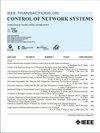Fixed-Time Formation Tracking for Heterogeneous Linear Multiagent Systems With a Nonautonomous Leader
IF 5
3区 计算机科学
Q2 AUTOMATION & CONTROL SYSTEMS
引用次数: 0
Abstract
This article studies the fixed-time time-varying formation (TVF) tracking control problem for heterogeneous multiagent systems with a nonautonomous leader under a directed communication network. The primary objective is to design a TVF tracking protocol enabling the followers to form the desired TVF while simultaneously tracking the output of the nonautonomous leader in a fixed time. First, a distributed fixed-time observer is proposed to estimate the state of the nonautonomous leader under a directed communication network. Then, utilizing coordinate transformation and sliding mode techniques, a fixed-time observer-based TVF tracking protocol is developed without requiring the full row rank assumption on the input matrix of the follower. It is proved via the Lyapunov stability theory that the fixed-time TVF tracking problem with a nonautonomous leader can be solved under the proposed protocol. Finally, the effectiveness of the proposed fixed-time TVF tracking control protocol is demonstrated by numerical examples.具有非自治领导者的异构线性多智能体系统的固定时间队形跟踪
研究了有向通信网络下具有非自治领导者的异构多智能体系统的固定时间时变编队跟踪控制问题。主要目标是设计一种TVF跟踪协议,使追随者能够形成期望的TVF,同时在固定时间内跟踪非自治领导者的输出。首先,提出了一种分布式固定时间观测器来估计有向通信网络下非自治leader的状态。然后,利用坐标变换和滑模技术,开发了一种基于固定时间观测器的TVF跟踪协议,而不需要对从动器的输入矩阵进行全行秩假设。通过Lyapunov稳定性理论证明,在该协议下可以解决具有非自治领导的固定时间TVF跟踪问题。最后,通过数值算例验证了所提定时TVF跟踪控制协议的有效性。
本文章由计算机程序翻译,如有差异,请以英文原文为准。
求助全文
约1分钟内获得全文
求助全文
来源期刊

IEEE Transactions on Control of Network Systems
Mathematics-Control and Optimization
CiteScore
7.80
自引率
7.10%
发文量
169
期刊介绍:
The IEEE Transactions on Control of Network Systems is committed to the timely publication of high-impact papers at the intersection of control systems and network science. In particular, the journal addresses research on the analysis, design and implementation of networked control systems, as well as control over networks. Relevant work includes the full spectrum from basic research on control systems to the design of engineering solutions for automatic control of, and over, networks. The topics covered by this journal include: Coordinated control and estimation over networks, Control and computation over sensor networks, Control under communication constraints, Control and performance analysis issues that arise in the dynamics of networks used in application areas such as communications, computers, transportation, manufacturing, Web ranking and aggregation, social networks, biology, power systems, economics, Synchronization of activities across a controlled network, Stability analysis of controlled networks, Analysis of networks as hybrid dynamical systems.
 求助内容:
求助内容: 应助结果提醒方式:
应助结果提醒方式:


